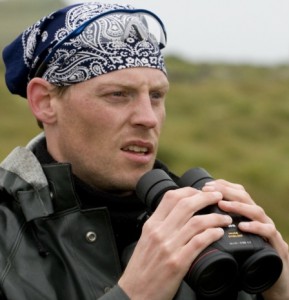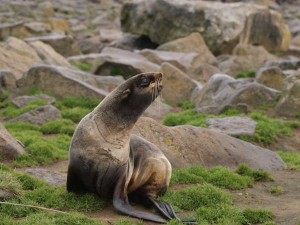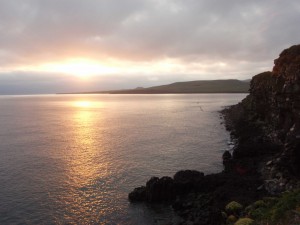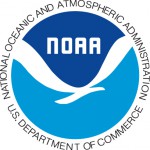
Searching for tagged seals
Alumni
MSc 2012
Tel: 604.822.8181
Fax: 604.822.8180
E-mail: c.nordstrom@oceans.ubc.ca
Supervisor: Dr. Andrew Trites
Education: BSc – Envirnonmental Biology (University of Alberta 2000)
Research Interests: Foraging ecology, Bio-telemetry, Habitat selection
Research Area: Alaskan Bering Sea
Where does mom get the groceries? – Environmental drivers of lactating fur seal foraging locations
Problem
Advances in technology have provided small electronic tags that will allow us to document seal locations and environmental parameters on a similar scale. By having the animals collect the data, we also benefit from simultaneous coverage at both St. Paul and Bogoslof Islands. We hope the results of our study will provide a clearer picture of the environmental conditions at each site and the attributes that attract these animals when they’re on foraging trips in the Bering Sea. Being able to predict where northern fur seals forage in a dynamic ocean environment would be helpful in explaining why some populations of fur seals are decreasing while others seem to be relatively healthy.
Research Questions
I am addressing the following questions: 1) How similar / different are the oceanographic conditions around St. Paul and Bogoslof Islands at a fur seal scale?; and 2) What environmental features influence fur seal foraging habitat in the eastern Bering Sea?
Approach
We took a bio-logging approach to answer our questions. Fieldwork focused on females with pups and we used nets to capture seals on the breeding beaches. Once caught, we would hold her long enough to glue an electronic logger to the fur on her back. The device recorded the seal’s GPS locations when at the surface as well as the depth and temperature of the water when she dove for food. After she returned from her next trip to sea, we would catch her again and remove the device. This way we had a complete record of where she traveled and the oceanic conditions she experienced while foraging.
Preliminary Findings
We had a very successful field season and recovered tags from more than 90 seals. Managing that much data has proved challenging but it has been checked and organized into an accessible database. Currently I’m analyzing water temperatures around different rookeries and calculating the strength and location of the thermocline in the water column. When that’s finished I’ll see if there’s any relationship between seal movements at-sea to these environmental features.
Publications
- Nordstrom, C.A., L.J. Wilson, S.J. Iverson and D.J. Tollit (2008). Evaluating Quantitative Fatty Acid Signature Analysis (QFASA) using harbour seals (Phoca vitulina richardsi) in captive feeding studies. Marine Ecology Progress Series 360: 245-263. pdf
- Nordstrom, C.A. 2002. Haul-out selection by Pacific harbor seals (Phoca vitulina richardsi): isolation and perceived predation risk. Marine Mammal Science 18(1): 194-205. pdf
Presentations
- Nordstrom, C.A. and A.W. Trites. 2009. Linking foraging patterns of northern fur seals (Callorhinus ursinus) with oceanographic features in the eastern Bering Sea. 18th Biennial Conference on the Biology of Marine Mammals, 12 – 16 October, Quebec City, Canada.
Links
| I appreciate the help and support provided by: | ||||
 |
||||





